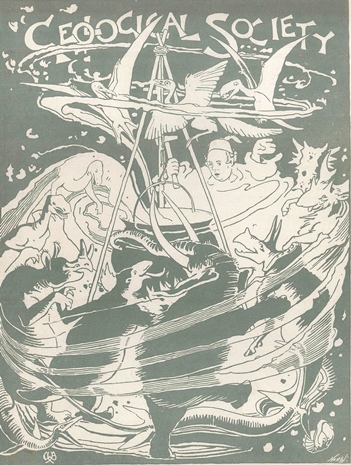
In November 2017 ten of the twelve water companies in the UK told the science blogger Sally LePage (via Twitter) that they employed the practice of water divining, or dowsing, despite the lack of scientific evidence for its effectiveness. But after the disclosure was first reported in The Guardian and then picked up by media across the world, many of the companies have tried to play down their claim. Nevertheless, belief in the effectiveness of water divining, continues to thrive and there remain many adherents, even among scientists.
Image: Cover of the menu for the Society’s Anniversary Dinner, Criterion, 16 February 1894. The Anniversary Dinners were traditionally held after AGMs. The image shows the then President Henry Woodward wearing his distinctive hat. Photo: Society Archive.
Although the British Society of Dowsers a Registered UK Charity founded in 1933 to promote dowsing in the United Kingdom and beyond, offers a wide range of training in the art, hydrogeologists generally remain sceptical. As they point out, a water diviner can walk over an aquifer such as the Chalk and predict that water will be found at a certain location, but a hydrogeologist knows that a well drilled almost anywhere on the Chalk will encounter some water.
Nothing new
The debate about water divining is nothing new. Henry Bolingbroke Woodward [1832 – 1921], Keeper of the Geological Department of the British Museum (now Natural History Museum) from 1880 – 1901) and in 1864 one of the founders of the Geological Magazine and its sole editor from 1865 to 1918, published a letter of his own in the November 1872 issue, entitled The Divining Rod in Somersetshire:
"Sir, One would imagine that the Divining-rod or Dowsing fork had become a thing of the past – that in these ‘enlightened’ days no man could go about with a forked hazel-twig pressed to his ribs and believe it could indicate a coal-crop, a metalliferous deposit or a water supply. Yet there are some who still cling without question to the faith of their fathers, on the principle that as it was in the beginning it should be now ... the fact appears that on the Mendip Hills the Divining rod is still used."
Woodward's incredulity about the continued use of divining rods elicited a speedy response and confirmation of its use from the East Anglian-based curator, prolific author and science populariser and geologist, John Ellor Taylor. Taylor had met with a similar response when he suggested that geological science – in the form of the newly published Geological Survey Memoir on the London Basin written by the geologist and leading authority on water supply and underground geology, William Whitaker [1835 – 1925] – might be a better bet when it came to finding water.
In the December 1872 issue of Geol. Mag., Taylor wrote:
“... A few days ago I was travelling in company with a gentleman to whom I had been introduced, who was a civil engineer and architect. He was telling me of some borings he had to conduct in Essex, in the London-clay, for water. I immediately referred him to Mr W. Whitaker's recently published memoir on the London Basin, in which is given such a copious list of well and other borings, thinking these might help him. I was replied to with a smile of self-satisfaction, and presently informed that when he wished to find water, he always used a forked hazel wand, which plainly and distinctly "turned in his hand" in the direction where water lay, and that he had never known this plan to fail!"
Therefore, Taylor concluded, tongue firmly in cheek:
“My purpose in writing is to recommend the practice to the Geological Survey, so that a corps of hazel-wand explorers might be formed and drilled! It would be a novelty to have a ‘Professor of the Divining Rod’ at Jermyn Street!"
But there may be more to Taylor's mischievous suggestion than meets the eye. As a young man Taylor had to choose between a religious and a scientific career, and grew up to be a companionable man of liberal and humane sympathies. In his teaching he aimed to reconcile orthodox science with reverence for the divine principle in creation. So perhaps the only reasonable conclusion Taylor could accept about the effectiveness of water divining was ' God only knows!'
Acknowledgements
Sources for this vignette include: letters from H B Woodward and J E Taylor, and a review of The Geology of the London Basin, published on pages xx , xxi and 474, 528 and 576, respectively in The Geological Magazine, vol. IX, 1872, The Dictionary of National Biography entry for John Ellor Taylor by Steven Plunkett, the obituary for Henry Woodward, Geological Magazine, vol. LVIII, 1921, pp. 481 – 484, and the obituary for William Whitaker, Nature, vol 115, 24 January 1925, pp. 129 -130; and an article about UK water companies and water divining by Matthew Weaver which appeared in The Guardian on 21 November 2017.
* Nina Morgan is a geologist and science writer based near Oxford. Her latest book, The Geology of Oxford Gravestones, is available via Gravestone Geology